MGMT1201 Business Report: Generational Communication Analysis
VerifiedAdded on 2022/09/16
|13
|2534
|17
Report
AI Summary
This business report, prepared for Process Leadership, addresses communication challenges within the organization, focusing on the diverse communication needs of Baby Boomers, Generation X, and Millennials in North American offices. The report analyzes primary research data on communication preferences across age and gender groups, specifically examining the use of phone calls, texting, and email. Findings reveal significant differences in communication styles and preferences among the generations, highlighting the need for tailored approaches. For instance, phone calls are preferred by younger employees while email is preferred by Generation X and Millennials. Secondary data supports these findings, emphasizing the impact of digitalization on communication choices. The report concludes with recommendations to improve workplace communication, fostering a more effective and collaborative environment. The study provides valuable insights into communication dynamics and offers practical strategies for enhancing organizational efficiency.
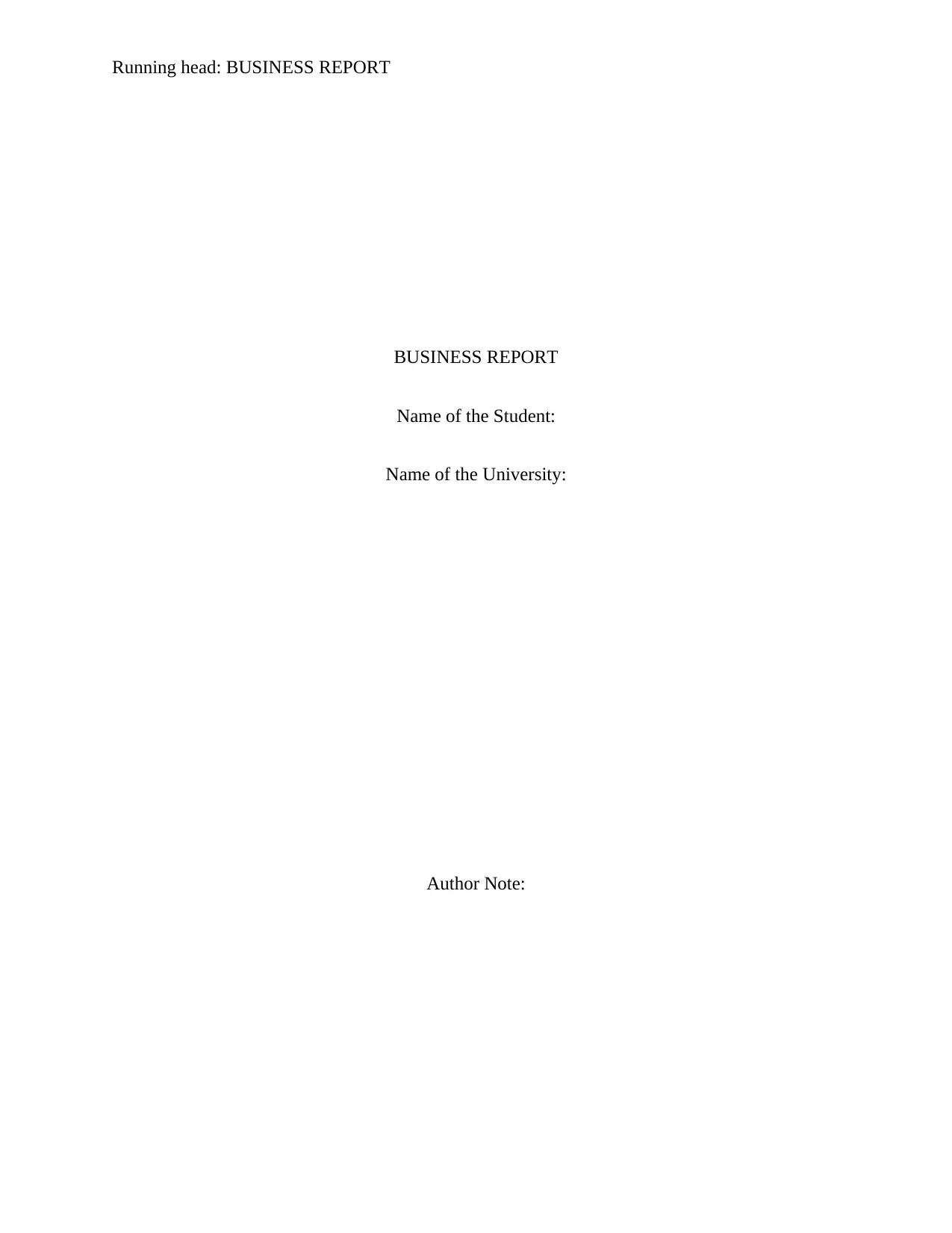
Running head: BUSINESS REPORT
BUSINESS REPORT
Name of the Student:
Name of the University:
Author Note:
BUSINESS REPORT
Name of the Student:
Name of the University:
Author Note:
Paraphrase This Document
Need a fresh take? Get an instant paraphrase of this document with our AI Paraphraser
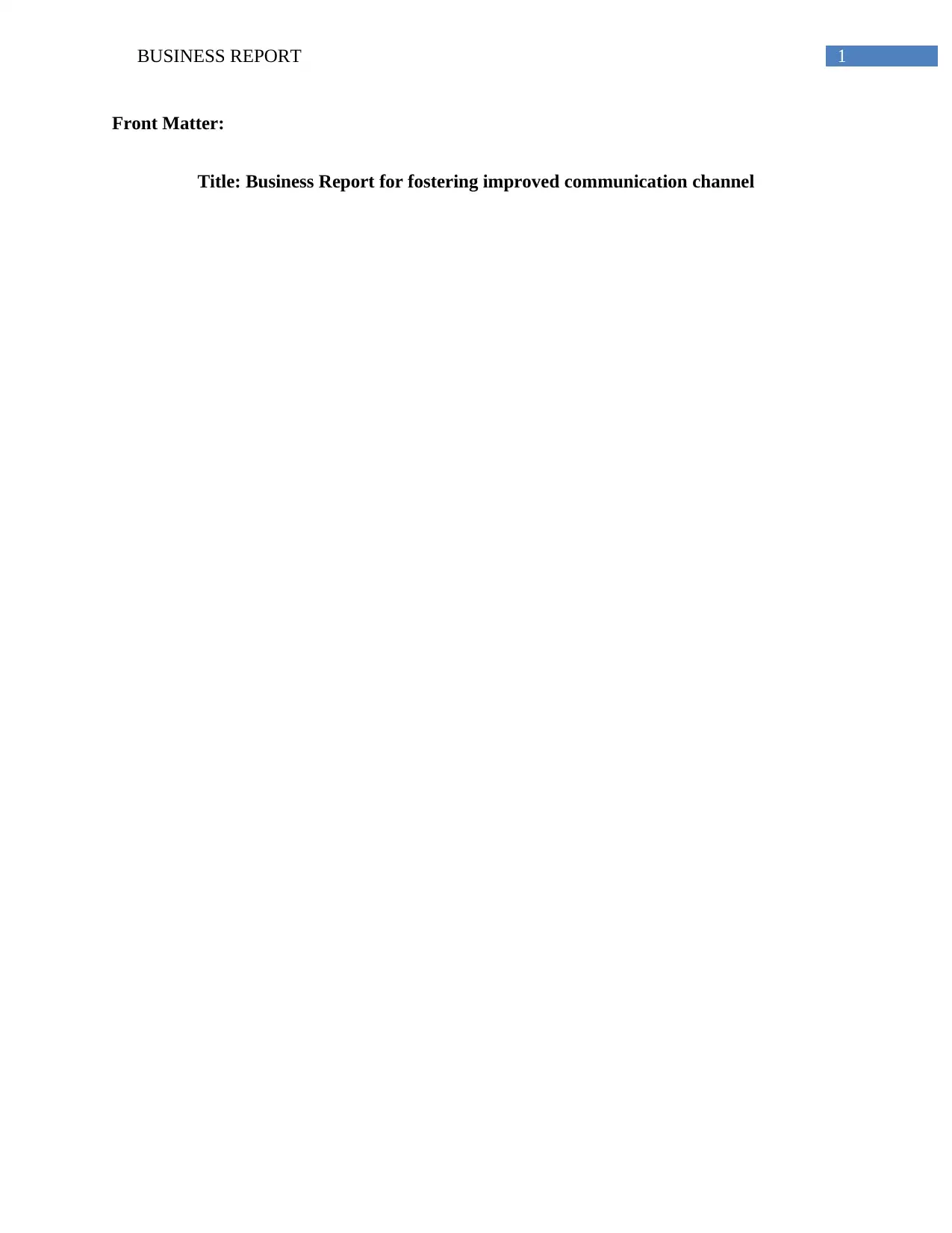
1BUSINESS REPORT
Front Matter:
Title: Business Report for fostering improved communication channel
Front Matter:
Title: Business Report for fostering improved communication channel
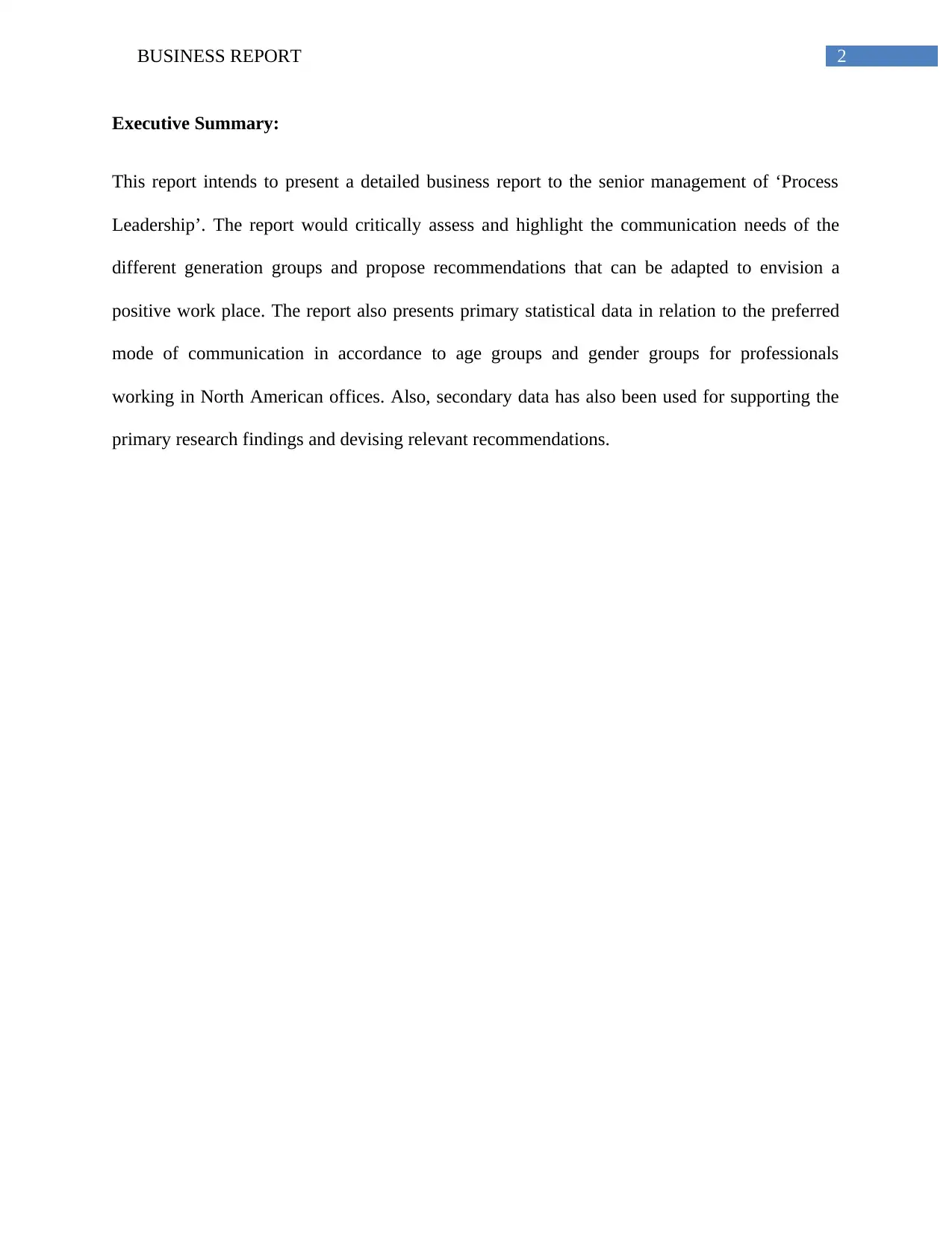
2BUSINESS REPORT
Executive Summary:
This report intends to present a detailed business report to the senior management of ‘Process
Leadership’. The report would critically assess and highlight the communication needs of the
different generation groups and propose recommendations that can be adapted to envision a
positive work place. The report also presents primary statistical data in relation to the preferred
mode of communication in accordance to age groups and gender groups for professionals
working in North American offices. Also, secondary data has also been used for supporting the
primary research findings and devising relevant recommendations.
Executive Summary:
This report intends to present a detailed business report to the senior management of ‘Process
Leadership’. The report would critically assess and highlight the communication needs of the
different generation groups and propose recommendations that can be adapted to envision a
positive work place. The report also presents primary statistical data in relation to the preferred
mode of communication in accordance to age groups and gender groups for professionals
working in North American offices. Also, secondary data has also been used for supporting the
primary research findings and devising relevant recommendations.
⊘ This is a preview!⊘
Do you want full access?
Subscribe today to unlock all pages.

Trusted by 1+ million students worldwide
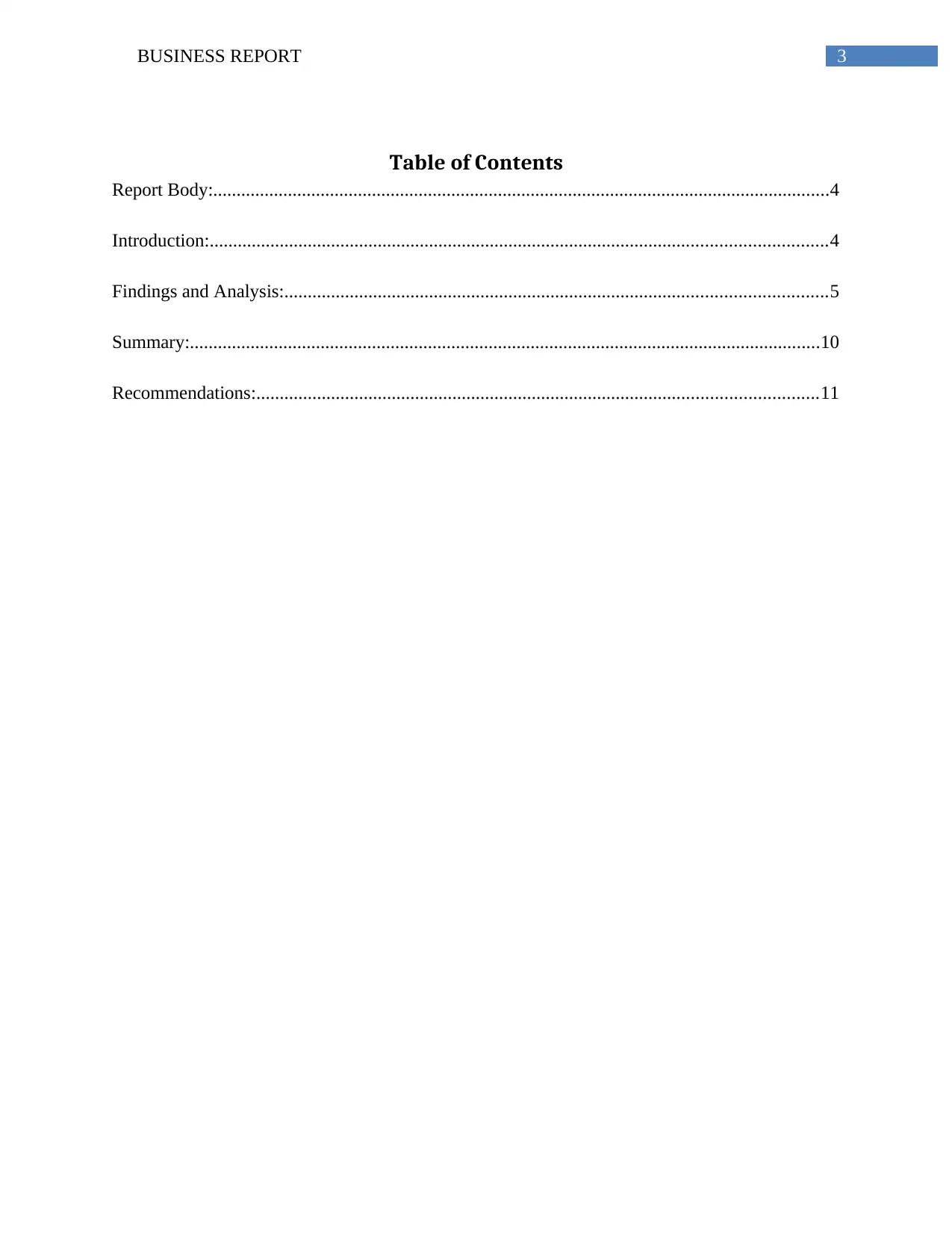
3BUSINESS REPORT
Table of Contents
Report Body:....................................................................................................................................4
Introduction:....................................................................................................................................4
Findings and Analysis:....................................................................................................................5
Summary:.......................................................................................................................................10
Recommendations:........................................................................................................................11
Table of Contents
Report Body:....................................................................................................................................4
Introduction:....................................................................................................................................4
Findings and Analysis:....................................................................................................................5
Summary:.......................................................................................................................................10
Recommendations:........................................................................................................................11
Paraphrase This Document
Need a fresh take? Get an instant paraphrase of this document with our AI Paraphraser
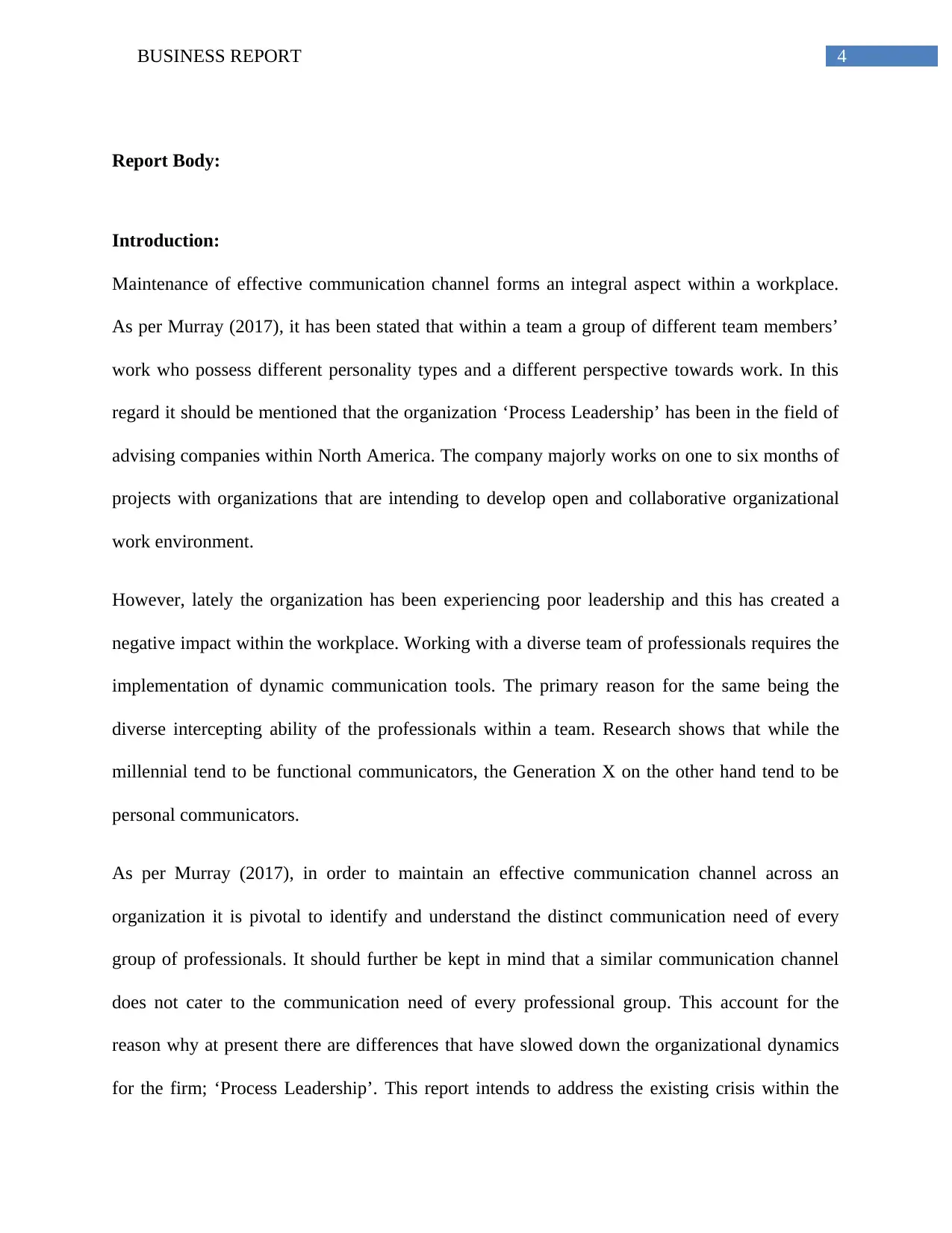
4BUSINESS REPORT
Report Body:
Introduction:
Maintenance of effective communication channel forms an integral aspect within a workplace.
As per Murray (2017), it has been stated that within a team a group of different team members’
work who possess different personality types and a different perspective towards work. In this
regard it should be mentioned that the organization ‘Process Leadership’ has been in the field of
advising companies within North America. The company majorly works on one to six months of
projects with organizations that are intending to develop open and collaborative organizational
work environment.
However, lately the organization has been experiencing poor leadership and this has created a
negative impact within the workplace. Working with a diverse team of professionals requires the
implementation of dynamic communication tools. The primary reason for the same being the
diverse intercepting ability of the professionals within a team. Research shows that while the
millennial tend to be functional communicators, the Generation X on the other hand tend to be
personal communicators.
As per Murray (2017), in order to maintain an effective communication channel across an
organization it is pivotal to identify and understand the distinct communication need of every
group of professionals. It should further be kept in mind that a similar communication channel
does not cater to the communication need of every professional group. This account for the
reason why at present there are differences that have slowed down the organizational dynamics
for the firm; ‘Process Leadership’. This report intends to address the existing crisis within the
Report Body:
Introduction:
Maintenance of effective communication channel forms an integral aspect within a workplace.
As per Murray (2017), it has been stated that within a team a group of different team members’
work who possess different personality types and a different perspective towards work. In this
regard it should be mentioned that the organization ‘Process Leadership’ has been in the field of
advising companies within North America. The company majorly works on one to six months of
projects with organizations that are intending to develop open and collaborative organizational
work environment.
However, lately the organization has been experiencing poor leadership and this has created a
negative impact within the workplace. Working with a diverse team of professionals requires the
implementation of dynamic communication tools. The primary reason for the same being the
diverse intercepting ability of the professionals within a team. Research shows that while the
millennial tend to be functional communicators, the Generation X on the other hand tend to be
personal communicators.
As per Murray (2017), in order to maintain an effective communication channel across an
organization it is pivotal to identify and understand the distinct communication need of every
group of professionals. It should further be kept in mind that a similar communication channel
does not cater to the communication need of every professional group. This account for the
reason why at present there are differences that have slowed down the organizational dynamics
for the firm; ‘Process Leadership’. This report intends to address the existing crisis within the
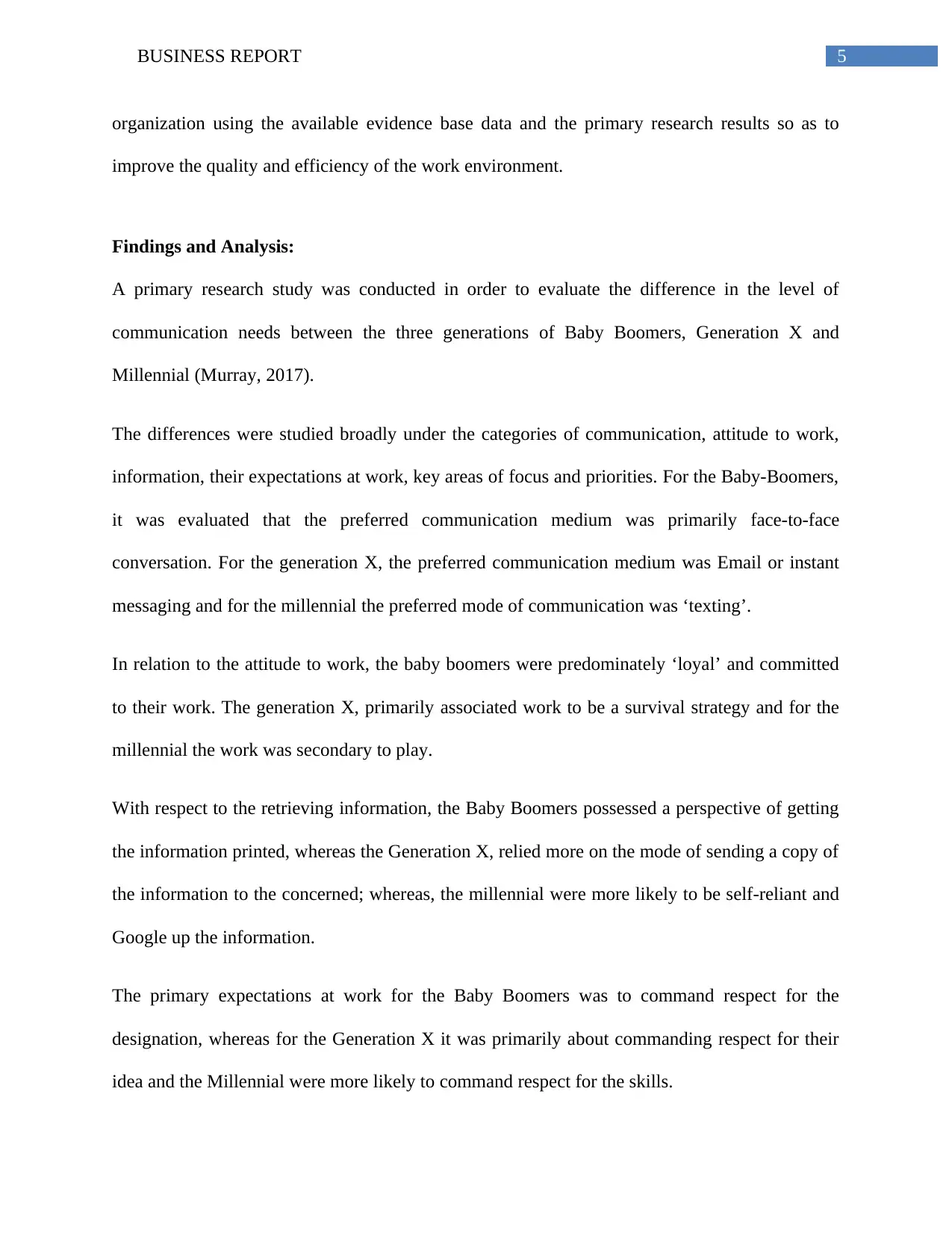
5BUSINESS REPORT
organization using the available evidence base data and the primary research results so as to
improve the quality and efficiency of the work environment.
Findings and Analysis:
A primary research study was conducted in order to evaluate the difference in the level of
communication needs between the three generations of Baby Boomers, Generation X and
Millennial (Murray, 2017).
The differences were studied broadly under the categories of communication, attitude to work,
information, their expectations at work, key areas of focus and priorities. For the Baby-Boomers,
it was evaluated that the preferred communication medium was primarily face-to-face
conversation. For the generation X, the preferred communication medium was Email or instant
messaging and for the millennial the preferred mode of communication was ‘texting’.
In relation to the attitude to work, the baby boomers were predominately ‘loyal’ and committed
to their work. The generation X, primarily associated work to be a survival strategy and for the
millennial the work was secondary to play.
With respect to the retrieving information, the Baby Boomers possessed a perspective of getting
the information printed, whereas the Generation X, relied more on the mode of sending a copy of
the information to the concerned; whereas, the millennial were more likely to be self-reliant and
Google up the information.
The primary expectations at work for the Baby Boomers was to command respect for the
designation, whereas for the Generation X it was primarily about commanding respect for their
idea and the Millennial were more likely to command respect for the skills.
organization using the available evidence base data and the primary research results so as to
improve the quality and efficiency of the work environment.
Findings and Analysis:
A primary research study was conducted in order to evaluate the difference in the level of
communication needs between the three generations of Baby Boomers, Generation X and
Millennial (Murray, 2017).
The differences were studied broadly under the categories of communication, attitude to work,
information, their expectations at work, key areas of focus and priorities. For the Baby-Boomers,
it was evaluated that the preferred communication medium was primarily face-to-face
conversation. For the generation X, the preferred communication medium was Email or instant
messaging and for the millennial the preferred mode of communication was ‘texting’.
In relation to the attitude to work, the baby boomers were predominately ‘loyal’ and committed
to their work. The generation X, primarily associated work to be a survival strategy and for the
millennial the work was secondary to play.
With respect to the retrieving information, the Baby Boomers possessed a perspective of getting
the information printed, whereas the Generation X, relied more on the mode of sending a copy of
the information to the concerned; whereas, the millennial were more likely to be self-reliant and
Google up the information.
The primary expectations at work for the Baby Boomers was to command respect for the
designation, whereas for the Generation X it was primarily about commanding respect for their
idea and the Millennial were more likely to command respect for the skills.
⊘ This is a preview!⊘
Do you want full access?
Subscribe today to unlock all pages.

Trusted by 1+ million students worldwide
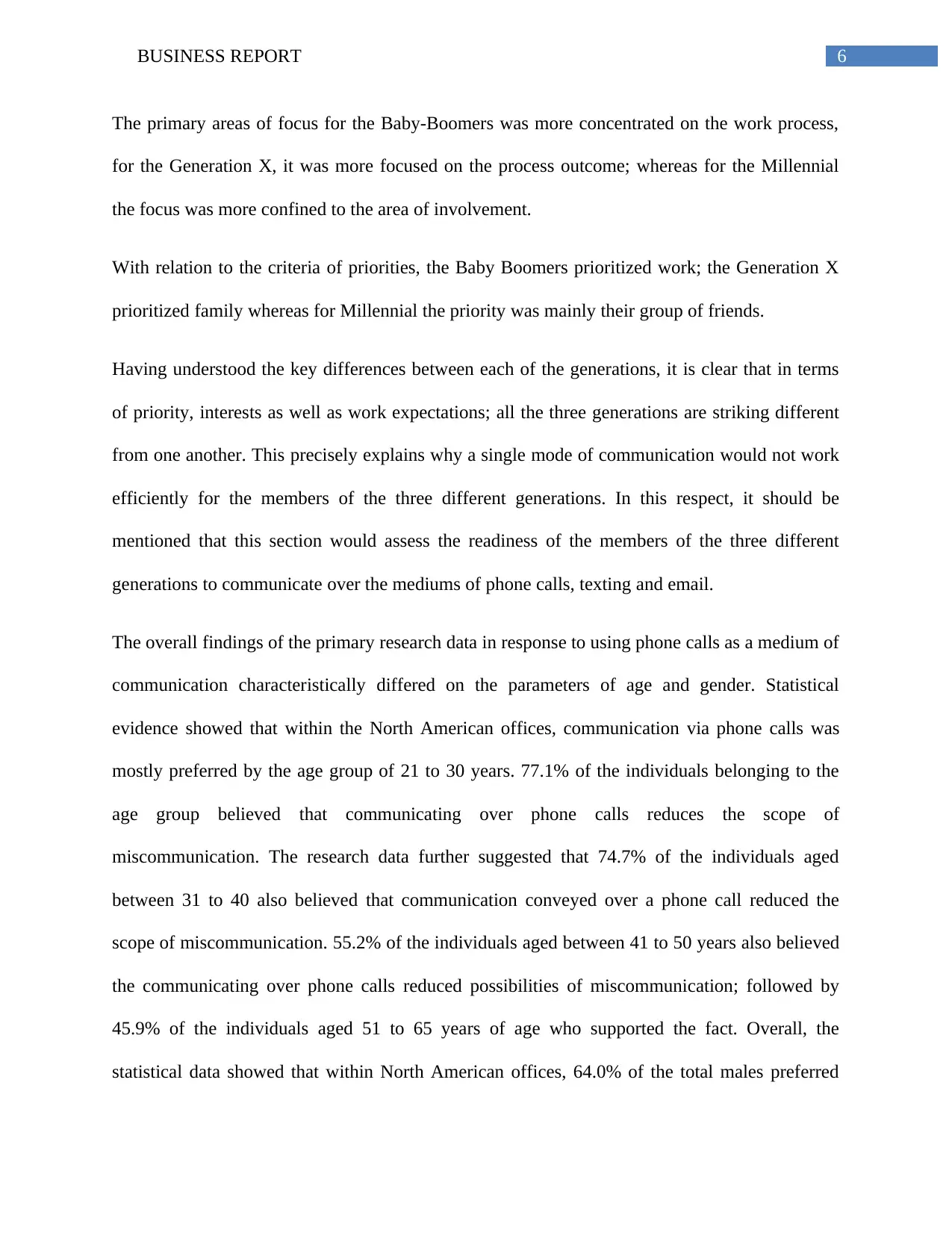
6BUSINESS REPORT
The primary areas of focus for the Baby-Boomers was more concentrated on the work process,
for the Generation X, it was more focused on the process outcome; whereas for the Millennial
the focus was more confined to the area of involvement.
With relation to the criteria of priorities, the Baby Boomers prioritized work; the Generation X
prioritized family whereas for Millennial the priority was mainly their group of friends.
Having understood the key differences between each of the generations, it is clear that in terms
of priority, interests as well as work expectations; all the three generations are striking different
from one another. This precisely explains why a single mode of communication would not work
efficiently for the members of the three different generations. In this respect, it should be
mentioned that this section would assess the readiness of the members of the three different
generations to communicate over the mediums of phone calls, texting and email.
The overall findings of the primary research data in response to using phone calls as a medium of
communication characteristically differed on the parameters of age and gender. Statistical
evidence showed that within the North American offices, communication via phone calls was
mostly preferred by the age group of 21 to 30 years. 77.1% of the individuals belonging to the
age group believed that communicating over phone calls reduces the scope of
miscommunication. The research data further suggested that 74.7% of the individuals aged
between 31 to 40 also believed that communication conveyed over a phone call reduced the
scope of miscommunication. 55.2% of the individuals aged between 41 to 50 years also believed
the communicating over phone calls reduced possibilities of miscommunication; followed by
45.9% of the individuals aged 51 to 65 years of age who supported the fact. Overall, the
statistical data showed that within North American offices, 64.0% of the total males preferred
The primary areas of focus for the Baby-Boomers was more concentrated on the work process,
for the Generation X, it was more focused on the process outcome; whereas for the Millennial
the focus was more confined to the area of involvement.
With relation to the criteria of priorities, the Baby Boomers prioritized work; the Generation X
prioritized family whereas for Millennial the priority was mainly their group of friends.
Having understood the key differences between each of the generations, it is clear that in terms
of priority, interests as well as work expectations; all the three generations are striking different
from one another. This precisely explains why a single mode of communication would not work
efficiently for the members of the three different generations. In this respect, it should be
mentioned that this section would assess the readiness of the members of the three different
generations to communicate over the mediums of phone calls, texting and email.
The overall findings of the primary research data in response to using phone calls as a medium of
communication characteristically differed on the parameters of age and gender. Statistical
evidence showed that within the North American offices, communication via phone calls was
mostly preferred by the age group of 21 to 30 years. 77.1% of the individuals belonging to the
age group believed that communicating over phone calls reduces the scope of
miscommunication. The research data further suggested that 74.7% of the individuals aged
between 31 to 40 also believed that communication conveyed over a phone call reduced the
scope of miscommunication. 55.2% of the individuals aged between 41 to 50 years also believed
the communicating over phone calls reduced possibilities of miscommunication; followed by
45.9% of the individuals aged 51 to 65 years of age who supported the fact. Overall, the
statistical data showed that within North American offices, 64.0% of the total males preferred
Paraphrase This Document
Need a fresh take? Get an instant paraphrase of this document with our AI Paraphraser
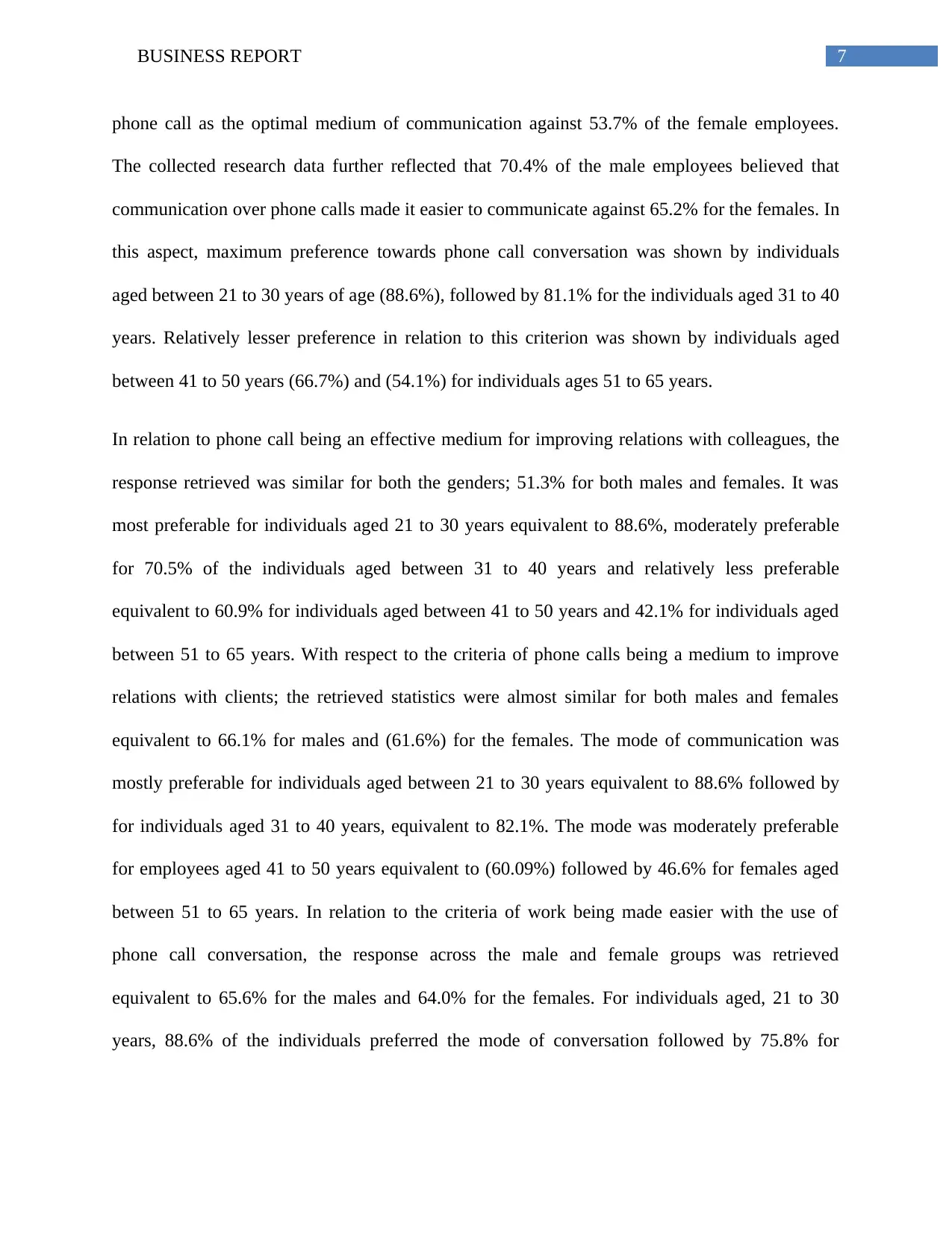
7BUSINESS REPORT
phone call as the optimal medium of communication against 53.7% of the female employees.
The collected research data further reflected that 70.4% of the male employees believed that
communication over phone calls made it easier to communicate against 65.2% for the females. In
this aspect, maximum preference towards phone call conversation was shown by individuals
aged between 21 to 30 years of age (88.6%), followed by 81.1% for the individuals aged 31 to 40
years. Relatively lesser preference in relation to this criterion was shown by individuals aged
between 41 to 50 years (66.7%) and (54.1%) for individuals ages 51 to 65 years.
In relation to phone call being an effective medium for improving relations with colleagues, the
response retrieved was similar for both the genders; 51.3% for both males and females. It was
most preferable for individuals aged 21 to 30 years equivalent to 88.6%, moderately preferable
for 70.5% of the individuals aged between 31 to 40 years and relatively less preferable
equivalent to 60.9% for individuals aged between 41 to 50 years and 42.1% for individuals aged
between 51 to 65 years. With respect to the criteria of phone calls being a medium to improve
relations with clients; the retrieved statistics were almost similar for both males and females
equivalent to 66.1% for males and (61.6%) for the females. The mode of communication was
mostly preferable for individuals aged between 21 to 30 years equivalent to 88.6% followed by
for individuals aged 31 to 40 years, equivalent to 82.1%. The mode was moderately preferable
for employees aged 41 to 50 years equivalent to (60.09%) followed by 46.6% for females aged
between 51 to 65 years. In relation to the criteria of work being made easier with the use of
phone call conversation, the response across the male and female groups was retrieved
equivalent to 65.6% for the males and 64.0% for the females. For individuals aged, 21 to 30
years, 88.6% of the individuals preferred the mode of conversation followed by 75.8% for
phone call as the optimal medium of communication against 53.7% of the female employees.
The collected research data further reflected that 70.4% of the male employees believed that
communication over phone calls made it easier to communicate against 65.2% for the females. In
this aspect, maximum preference towards phone call conversation was shown by individuals
aged between 21 to 30 years of age (88.6%), followed by 81.1% for the individuals aged 31 to 40
years. Relatively lesser preference in relation to this criterion was shown by individuals aged
between 41 to 50 years (66.7%) and (54.1%) for individuals ages 51 to 65 years.
In relation to phone call being an effective medium for improving relations with colleagues, the
response retrieved was similar for both the genders; 51.3% for both males and females. It was
most preferable for individuals aged 21 to 30 years equivalent to 88.6%, moderately preferable
for 70.5% of the individuals aged between 31 to 40 years and relatively less preferable
equivalent to 60.9% for individuals aged between 41 to 50 years and 42.1% for individuals aged
between 51 to 65 years. With respect to the criteria of phone calls being a medium to improve
relations with clients; the retrieved statistics were almost similar for both males and females
equivalent to 66.1% for males and (61.6%) for the females. The mode of communication was
mostly preferable for individuals aged between 21 to 30 years equivalent to 88.6% followed by
for individuals aged 31 to 40 years, equivalent to 82.1%. The mode was moderately preferable
for employees aged 41 to 50 years equivalent to (60.09%) followed by 46.6% for females aged
between 51 to 65 years. In relation to the criteria of work being made easier with the use of
phone call conversation, the response across the male and female groups was retrieved
equivalent to 65.6% for the males and 64.0% for the females. For individuals aged, 21 to 30
years, 88.6% of the individuals preferred the mode of conversation followed by 75.8% for
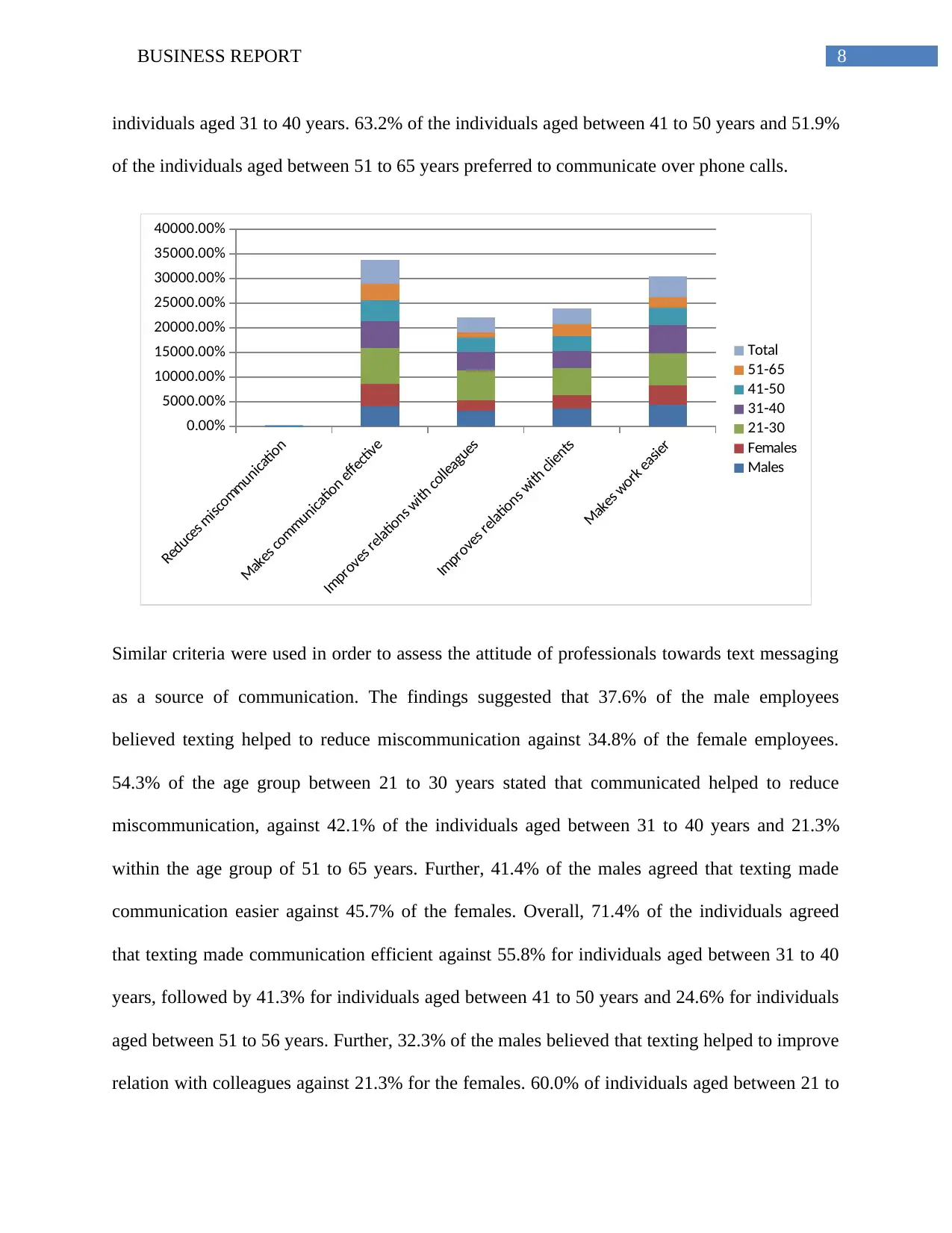
8BUSINESS REPORT
individuals aged 31 to 40 years. 63.2% of the individuals aged between 41 to 50 years and 51.9%
of the individuals aged between 51 to 65 years preferred to communicate over phone calls.
Reduces miscommunication
Makes communication effective
Improves relations with colleagues
Improves relations with clients
Makes work easier
0.00%
5000.00%
10000.00%
15000.00%
20000.00%
25000.00%
30000.00%
35000.00%
40000.00%
Total
51-65
41-50
31-40
21-30
Females
Males
Similar criteria were used in order to assess the attitude of professionals towards text messaging
as a source of communication. The findings suggested that 37.6% of the male employees
believed texting helped to reduce miscommunication against 34.8% of the female employees.
54.3% of the age group between 21 to 30 years stated that communicated helped to reduce
miscommunication, against 42.1% of the individuals aged between 31 to 40 years and 21.3%
within the age group of 51 to 65 years. Further, 41.4% of the males agreed that texting made
communication easier against 45.7% of the females. Overall, 71.4% of the individuals agreed
that texting made communication efficient against 55.8% for individuals aged between 31 to 40
years, followed by 41.3% for individuals aged between 41 to 50 years and 24.6% for individuals
aged between 51 to 56 years. Further, 32.3% of the males believed that texting helped to improve
relation with colleagues against 21.3% for the females. 60.0% of individuals aged between 21 to
individuals aged 31 to 40 years. 63.2% of the individuals aged between 41 to 50 years and 51.9%
of the individuals aged between 51 to 65 years preferred to communicate over phone calls.
Reduces miscommunication
Makes communication effective
Improves relations with colleagues
Improves relations with clients
Makes work easier
0.00%
5000.00%
10000.00%
15000.00%
20000.00%
25000.00%
30000.00%
35000.00%
40000.00%
Total
51-65
41-50
31-40
21-30
Females
Males
Similar criteria were used in order to assess the attitude of professionals towards text messaging
as a source of communication. The findings suggested that 37.6% of the male employees
believed texting helped to reduce miscommunication against 34.8% of the female employees.
54.3% of the age group between 21 to 30 years stated that communicated helped to reduce
miscommunication, against 42.1% of the individuals aged between 31 to 40 years and 21.3%
within the age group of 51 to 65 years. Further, 41.4% of the males agreed that texting made
communication easier against 45.7% of the females. Overall, 71.4% of the individuals agreed
that texting made communication efficient against 55.8% for individuals aged between 31 to 40
years, followed by 41.3% for individuals aged between 41 to 50 years and 24.6% for individuals
aged between 51 to 56 years. Further, 32.3% of the males believed that texting helped to improve
relation with colleagues against 21.3% for the females. 60.0% of individuals aged between 21 to
⊘ This is a preview!⊘
Do you want full access?
Subscribe today to unlock all pages.

Trusted by 1+ million students worldwide
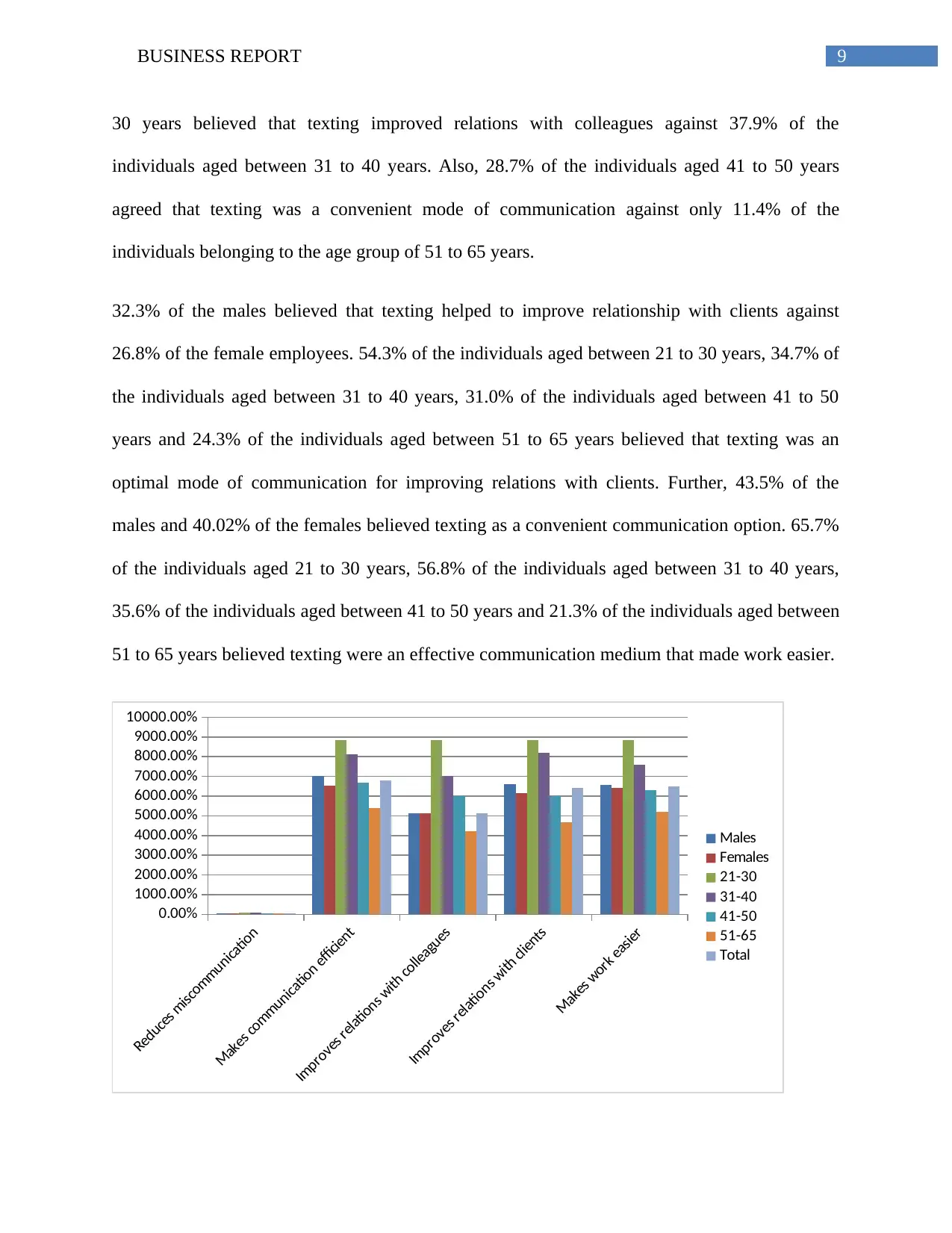
9BUSINESS REPORT
30 years believed that texting improved relations with colleagues against 37.9% of the
individuals aged between 31 to 40 years. Also, 28.7% of the individuals aged 41 to 50 years
agreed that texting was a convenient mode of communication against only 11.4% of the
individuals belonging to the age group of 51 to 65 years.
32.3% of the males believed that texting helped to improve relationship with clients against
26.8% of the female employees. 54.3% of the individuals aged between 21 to 30 years, 34.7% of
the individuals aged between 31 to 40 years, 31.0% of the individuals aged between 41 to 50
years and 24.3% of the individuals aged between 51 to 65 years believed that texting was an
optimal mode of communication for improving relations with clients. Further, 43.5% of the
males and 40.02% of the females believed texting as a convenient communication option. 65.7%
of the individuals aged 21 to 30 years, 56.8% of the individuals aged between 31 to 40 years,
35.6% of the individuals aged between 41 to 50 years and 21.3% of the individuals aged between
51 to 65 years believed texting were an effective communication medium that made work easier.
Reduces miscommunication
Makes communication efficient
Improves relations with colleagues
Improves relations with clients
Makes work easier
0.00%
1000.00%
2000.00%
3000.00%
4000.00%
5000.00%
6000.00%
7000.00%
8000.00%
9000.00%
10000.00%
Males
Females
21-30
31-40
41-50
51-65
Total
30 years believed that texting improved relations with colleagues against 37.9% of the
individuals aged between 31 to 40 years. Also, 28.7% of the individuals aged 41 to 50 years
agreed that texting was a convenient mode of communication against only 11.4% of the
individuals belonging to the age group of 51 to 65 years.
32.3% of the males believed that texting helped to improve relationship with clients against
26.8% of the female employees. 54.3% of the individuals aged between 21 to 30 years, 34.7% of
the individuals aged between 31 to 40 years, 31.0% of the individuals aged between 41 to 50
years and 24.3% of the individuals aged between 51 to 65 years believed that texting was an
optimal mode of communication for improving relations with clients. Further, 43.5% of the
males and 40.02% of the females believed texting as a convenient communication option. 65.7%
of the individuals aged 21 to 30 years, 56.8% of the individuals aged between 31 to 40 years,
35.6% of the individuals aged between 41 to 50 years and 21.3% of the individuals aged between
51 to 65 years believed texting were an effective communication medium that made work easier.
Reduces miscommunication
Makes communication efficient
Improves relations with colleagues
Improves relations with clients
Makes work easier
0.00%
1000.00%
2000.00%
3000.00%
4000.00%
5000.00%
6000.00%
7000.00%
8000.00%
9000.00%
10000.00%
Males
Females
21-30
31-40
41-50
51-65
Total
Paraphrase This Document
Need a fresh take? Get an instant paraphrase of this document with our AI Paraphraser
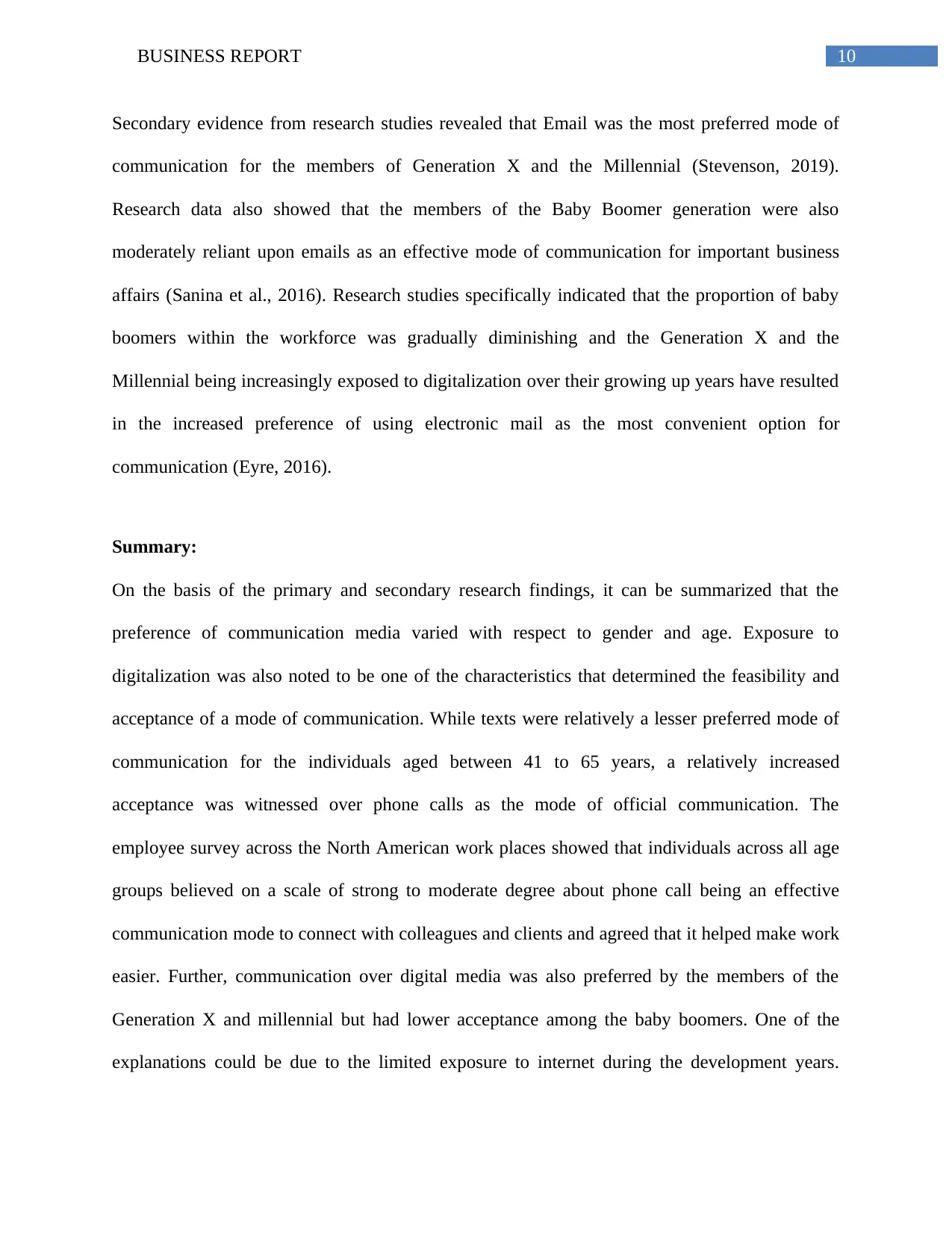
10BUSINESS REPORT
Secondary evidence from research studies revealed that Email was the most preferred mode of
communication for the members of Generation X and the Millennial (Stevenson, 2019).
Research data also showed that the members of the Baby Boomer generation were also
moderately reliant upon emails as an effective mode of communication for important business
affairs (Sanina et al., 2016). Research studies specifically indicated that the proportion of baby
boomers within the workforce was gradually diminishing and the Generation X and the
Millennial being increasingly exposed to digitalization over their growing up years have resulted
in the increased preference of using electronic mail as the most convenient option for
communication (Eyre, 2016).
Summary:
On the basis of the primary and secondary research findings, it can be summarized that the
preference of communication media varied with respect to gender and age. Exposure to
digitalization was also noted to be one of the characteristics that determined the feasibility and
acceptance of a mode of communication. While texts were relatively a lesser preferred mode of
communication for the individuals aged between 41 to 65 years, a relatively increased
acceptance was witnessed over phone calls as the mode of official communication. The
employee survey across the North American work places showed that individuals across all age
groups believed on a scale of strong to moderate degree about phone call being an effective
communication mode to connect with colleagues and clients and agreed that it helped make work
easier. Further, communication over digital media was also preferred by the members of the
Generation X and millennial but had lower acceptance among the baby boomers. One of the
explanations could be due to the limited exposure to internet during the development years.
Secondary evidence from research studies revealed that Email was the most preferred mode of
communication for the members of Generation X and the Millennial (Stevenson, 2019).
Research data also showed that the members of the Baby Boomer generation were also
moderately reliant upon emails as an effective mode of communication for important business
affairs (Sanina et al., 2016). Research studies specifically indicated that the proportion of baby
boomers within the workforce was gradually diminishing and the Generation X and the
Millennial being increasingly exposed to digitalization over their growing up years have resulted
in the increased preference of using electronic mail as the most convenient option for
communication (Eyre, 2016).
Summary:
On the basis of the primary and secondary research findings, it can be summarized that the
preference of communication media varied with respect to gender and age. Exposure to
digitalization was also noted to be one of the characteristics that determined the feasibility and
acceptance of a mode of communication. While texts were relatively a lesser preferred mode of
communication for the individuals aged between 41 to 65 years, a relatively increased
acceptance was witnessed over phone calls as the mode of official communication. The
employee survey across the North American work places showed that individuals across all age
groups believed on a scale of strong to moderate degree about phone call being an effective
communication mode to connect with colleagues and clients and agreed that it helped make work
easier. Further, communication over digital media was also preferred by the members of the
Generation X and millennial but had lower acceptance among the baby boomers. One of the
explanations could be due to the limited exposure to internet during the development years.
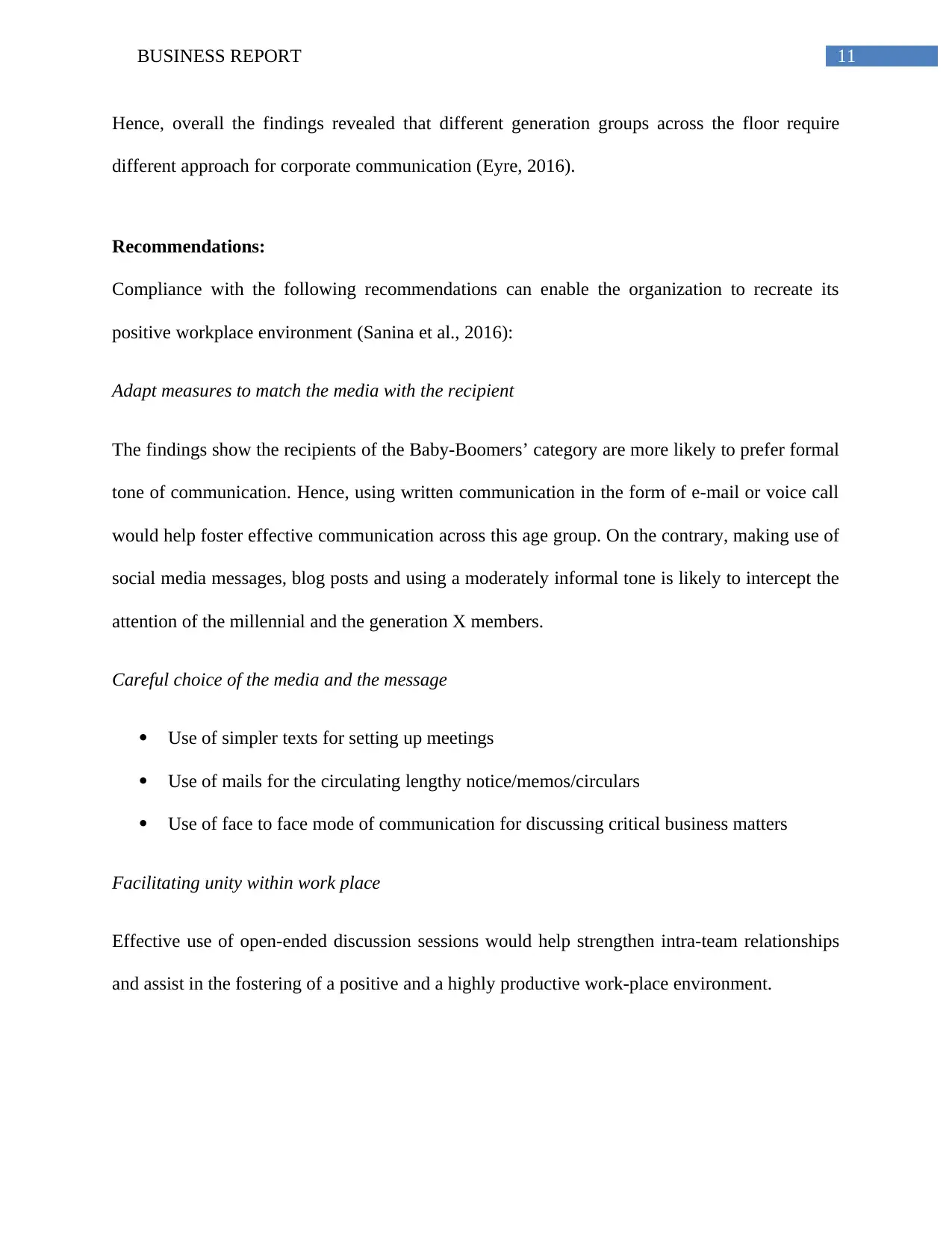
11BUSINESS REPORT
Hence, overall the findings revealed that different generation groups across the floor require
different approach for corporate communication (Eyre, 2016).
Recommendations:
Compliance with the following recommendations can enable the organization to recreate its
positive workplace environment (Sanina et al., 2016):
Adapt measures to match the media with the recipient
The findings show the recipients of the Baby-Boomers’ category are more likely to prefer formal
tone of communication. Hence, using written communication in the form of e-mail or voice call
would help foster effective communication across this age group. On the contrary, making use of
social media messages, blog posts and using a moderately informal tone is likely to intercept the
attention of the millennial and the generation X members.
Careful choice of the media and the message
Use of simpler texts for setting up meetings
Use of mails for the circulating lengthy notice/memos/circulars
Use of face to face mode of communication for discussing critical business matters
Facilitating unity within work place
Effective use of open-ended discussion sessions would help strengthen intra-team relationships
and assist in the fostering of a positive and a highly productive work-place environment.
Hence, overall the findings revealed that different generation groups across the floor require
different approach for corporate communication (Eyre, 2016).
Recommendations:
Compliance with the following recommendations can enable the organization to recreate its
positive workplace environment (Sanina et al., 2016):
Adapt measures to match the media with the recipient
The findings show the recipients of the Baby-Boomers’ category are more likely to prefer formal
tone of communication. Hence, using written communication in the form of e-mail or voice call
would help foster effective communication across this age group. On the contrary, making use of
social media messages, blog posts and using a moderately informal tone is likely to intercept the
attention of the millennial and the generation X members.
Careful choice of the media and the message
Use of simpler texts for setting up meetings
Use of mails for the circulating lengthy notice/memos/circulars
Use of face to face mode of communication for discussing critical business matters
Facilitating unity within work place
Effective use of open-ended discussion sessions would help strengthen intra-team relationships
and assist in the fostering of a positive and a highly productive work-place environment.
⊘ This is a preview!⊘
Do you want full access?
Subscribe today to unlock all pages.

Trusted by 1+ million students worldwide
1 out of 13
Related Documents
Your All-in-One AI-Powered Toolkit for Academic Success.
+13062052269
info@desklib.com
Available 24*7 on WhatsApp / Email
![[object Object]](/_next/static/media/star-bottom.7253800d.svg)
Unlock your academic potential
Copyright © 2020–2025 A2Z Services. All Rights Reserved. Developed and managed by ZUCOL.





